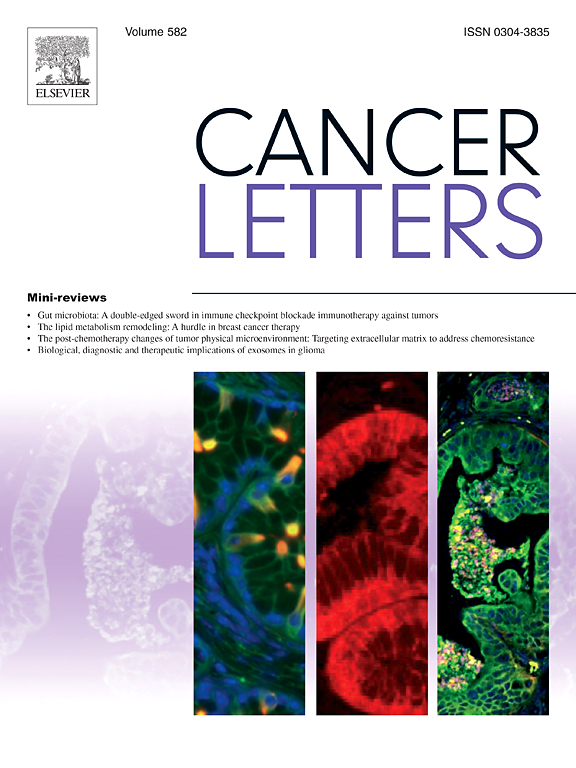基底样乳腺癌中亚型特异性HER3的富集是通过GATA2/ GATA3-FOXA1轴调控的
IF 10.1
1区 医学
Q1 ONCOLOGY
引用次数: 0
摘要
基底样乳腺癌(BLBC)是三阴性乳腺癌(TNBC)的一个主要亚型,其特点是行为具有侵袭性,治疗选择有限,预后差。虽然在TNBC中经常观察到HER3过表达并与不良预后相关,但其亚型特异性表达和治疗潜力尚不清楚。在这里,我们通过转录组分析证明,与低CLBC相比,HER3信号在BLBC中选择性地过度激活。组蛋白去乙酰化酶抑制剂(HDACi)、罗米地辛和帕比司他通过选择性下调HER3的表达,对BLBC发挥了有效的抗肿瘤作用。HER3水平与FOXA1呈正相关,FOXA1是一个关键的转录激活因子。在机制上,我们确定了GATA2和GATA3是FOXA1和HER3的上游调节因子。HDACi通过抑制GATA2和GATA3的表达来破坏GATA2/GATA3- foxa1 - her3轴。特异性敲低FOXA1、GATA2或GATA3可增强HDACi诱导的细胞凋亡和生长抑制,而任何这些转录因子的异位表达可恢复HER3水平并减轻HDACi的影响。染色质免疫沉淀法证实了GATA2和GATA3与FOXA1启动子的直接结合。在BLBC异种移植模型中,GATA2过表达显著降低了Panobinostat的抗肿瘤活性,并显著逆转了其对FOXA1和HER3表达、肿瘤生长和凋亡的影响。在临床上,高表达的GATA2、GATA3、FOXA1或HER3与BLBC患者的不良预后显著相关。总的来说,我们的研究确定了先前未被识别的GATA2/GATA3-FOXA1-HER3轴是BLBC进展的关键调控网络。我们提供了强有力的实验数据,支持两种HDACi,罗米地辛和帕比诺他可能被重新用作BLBC的有效治疗剂。本文章由计算机程序翻译,如有差异,请以英文原文为准。
Subtype-specific HER3 enrichment in basal-like breast cancer is regulated via the GATA2/GATA3–FOXA1 axis
Basal-like breast cancer (BLBC) is a major subtype of triple-negative breast cancer (TNBC), characterized by aggressive behavior, limited treatment options, and poor prognosis. While HER3 overexpression is frequently observed in TNBC and associated with poor outcomes, its subtype-specific expression and therapeutic potential remain unclear. Here, we demonstrated that HER3 signaling is selectively hyperactivated in BLBC compared to claudin-low breast cancer (CLBC) using transcriptomic profiling. Histone deacetylase inhibitors (HDACi), Romidepsin and Panobinostat, exerted potent antitumor effects on BLBC by selectively downregulating HER3 expression. HER3 levels were positively correlated with FOXA1, a key transcriptional activator. Mechanistically, we identified GATA2 and GATA3 as upstream regulators of both FOXA1 and HER3. HDACi disrupted the GATA2/GATA3-FOXA1-HER3 axis by suppressing GATA2 and GATA3 expressions. Specific knockdown of FOXA1, GATA2, or GATA3 enhanced HDACi-induced apoptosis and growth inhibition, while ectopic expression of any of these transcription factors restored HER3 levels and mitigated the effects of HDACi. Chromatin immunoprecipitation assays confirmed direct binding of GATA2 and GATA3 to the FOXA1 promoter. In BLBC xenograft models, GATA2 overexpression markedly attenuated the antitumor activity of Panobinostat and substantially reversed its effects on FOXA1 and HER3 expression, tumor growth, and apoptosis. Clinically, high expression of GATA2, GATA3, FOXA1, or HER3 is significantly associated with poor outcomes in BLBC patients. Collectively, our studies established a previously unrecognized GATA2/GATA3-FOXA1-HER3 axis as a key regulatory network in BLBC progression. We provide strong experimental data supporting that the two HDACi, Romidepsin and Panobinostat may be repurposed as effective therapeutic agents for BLBC.
求助全文
通过发布文献求助,成功后即可免费获取论文全文。
去求助
来源期刊

Cancer letters
医学-肿瘤学
CiteScore
17.70
自引率
2.10%
发文量
427
审稿时长
15 days
期刊介绍:
Cancer Letters is a reputable international journal that serves as a platform for significant and original contributions in cancer research. The journal welcomes both full-length articles and Mini Reviews in the wide-ranging field of basic and translational oncology. Furthermore, it frequently presents Special Issues that shed light on current and topical areas in cancer research.
Cancer Letters is highly interested in various fundamental aspects that can cater to a diverse readership. These areas include the molecular genetics and cell biology of cancer, radiation biology, molecular pathology, hormones and cancer, viral oncology, metastasis, and chemoprevention. The journal actively focuses on experimental therapeutics, particularly the advancement of targeted therapies for personalized cancer medicine, such as metronomic chemotherapy.
By publishing groundbreaking research and promoting advancements in cancer treatments, Cancer Letters aims to actively contribute to the fight against cancer and the improvement of patient outcomes.
 求助内容:
求助内容: 应助结果提醒方式:
应助结果提醒方式:


